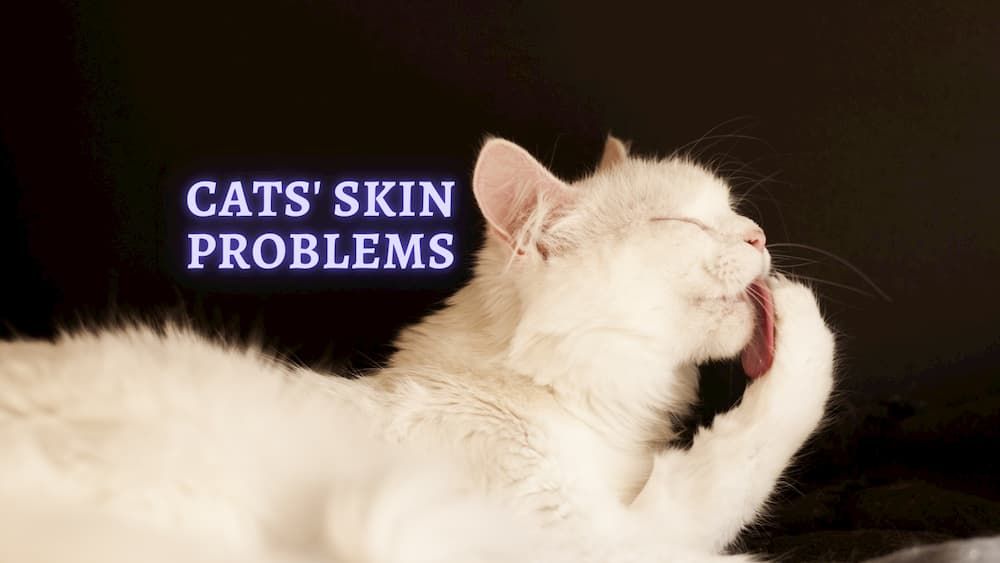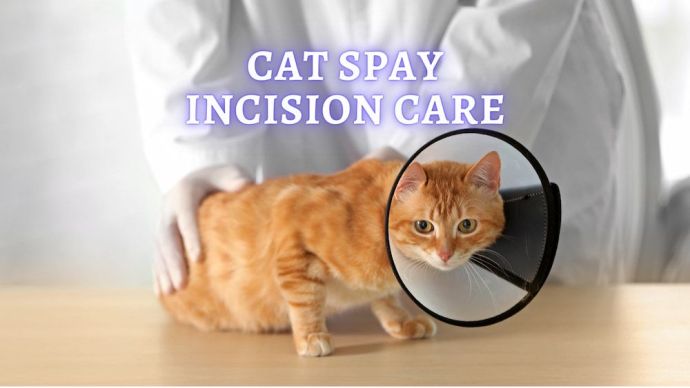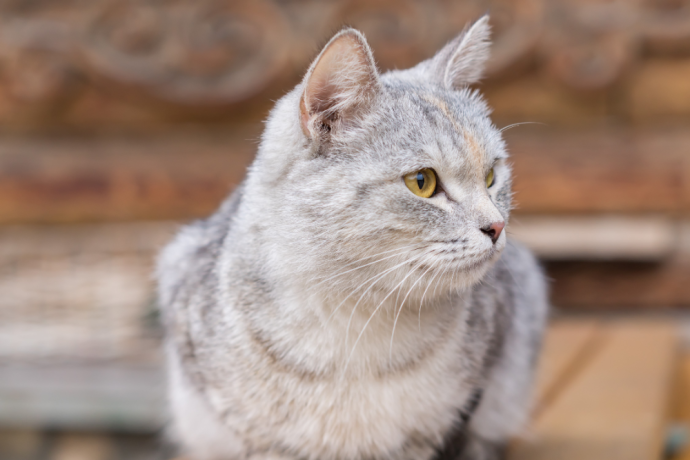Skin Problems in Cats: Guide from Dr. Kathryn Dench
Written by:
Author: Dr. Kathryn Dench
Dr. Kathryn Dench is an experience veterinary with over 10 years' experience in small animal and exotic pet medicine. Kate qualified from Cambridge University Veterinary School in 2007. Kate has worked in a number of veterinary practices in the UK. She has extensive experience in the medical care of pet species, from dogs and cats to chickens and chameleons! In free time, Kate writes pet advice in order to ensure that owners are receiving the best possible information on how to care for their pets.
View all 9 articlesLearn about our editorial process and veterinary review board.
Viewed: 222
Updated on: 05/17/2023
As cat owners, we want the feline members of our family to be happy and comfortable. And yet research suggests that between 6 and 15 percent of our domestic cats may suffer from skin conditions.[1] Is it possible that our cats have skin conditions that we’re unaware of? And if we do notice something unusual, should we be worried?
Cats are very individual creatures whose skin conditions are no less unique. Some cats with an epidermis disorder might have a rash or what looks like dry skin. There may be bald patches, noticeable lesions, and even a bad smell in other cases. In some pets, the only indication that anything is wrong is that they are licking or scratching a bit more than usual or their coat looks in poor condition. Add to this the naturally secretive attitudes of many pets. It’s no wonder that skin problems can go unnoticed for some time.
In this article, we delve a little deeper into cat skin problems, looking at what causes them, how to recognize them, and what we, as pet owners, should do about them.
Fleas are a ubiquitous problem for our pet cats. Approximately 10% of cats have fleas, the leading cause of pet skin problems.[2] Typically, epidermis conditions caused by flea bites tend to concentrate along the cat’s spine, particularly the tail head and the back of the neck. In mild cases, you may notice a few scabs or peeling skin in these areas initially, but in more severe cases, the scabs can be found all over the body. Some pets with fleas are very itchy, and you may see them scratching or licking at their skin, but others barely seem to scratch.
Unfortunately, more than checking for fleas on your cat is required to ensure that fleas are not part of the problem. Adult fleas spend most of their time in the surrounding environment and only hop onto the animal to feed. So even if you don’t see fleas on your pet, they could be involved.
READ MORE: Vet Recommended Flea Treatment for Cats
2. Mites
Apart from fleas, there are another creepy crawlies that can cause skin problems in cats. Mites are microscopic insects that burrow into the cat’s skin and cause intense itchiness and inflammation. Mites tend to cause an intense itch that makes the cat scratch a lot, and the skin looks red and sore.
READ MORE: How to treat ear mites in Cats
3. Ticks
Ticks are another pest to watch out for. Although not as common on cats as on dogs, they can still latch onto your cat’s skin to feed and leave a sore bump when done. It is essential to be careful when removing any ticks you find, as their mouthparts can get left behind if pulled away from the skin, which can cause more irritation for your cat. There are special tools to help remove ticks if your cat is prone to getting them, and the staff at your local veterinary clinic can help show you the technique.
Implementing a good quality flea control regime is the first step in diagnosing or treating almost any cat epidermis problem. And the good news is that several veterinary-approved flea products also effectively prevent mite and tick problems in cats.
READ MORE: Cats Ticks and Fleas Control
4. Infections
The skin is one of the body’s main defenses against infection, acting as an impenetrable barrier around the body tissues. Anything that disturbs the skin’s delicate balance can throw this defense mechanism off-kilter, leaving the skin susceptible to infection. Sometimes the infection itself is the main problem, in which case treating it should solve it. In other cases, there is an underlying reason why the disease broke the epidermis’s barrier defenses, and that underlying cause needs to be addressed.
Bacterial skin infections
When we think of bacterial infections, pus or septic wounds often spring to mind. But skin infections don’t always look like that. Sometimes infected skin can just look dry and flaky. Other times, there may be ulcers or red, oozy patches known as hotspots, and other times it may look like acne or blackheads.
Skin infections in cats rarely heal well without medical intervention. The infected epidermis usually becomes itchy and sore, and the cat’s natural response is to lick, scratch, or bite at the area. This damages the skin further and introduces bacteria from the cat’s mouth into the vulnerable skin, making it more infected.
Fight wounds
Sometimes, the bacteria infecting a cat’s skin didn’t come from their own mouths and claws, but someone else’s! Catfight wounds are very common in cats, and even relatively shallow scratches can easily become infected. If your cat has a couple of scratches, it’s usually fine to keep an eye at home. Still, if they are covered in lacerations, it’s a good idea to get some medical attention.
Cat bites pose an even greater risk because the teeth break the skin and carry with them all sorts of bacteria from the other cat’s mouth. Sometimes little puncture wounds are visible on the skin from where the bite happened. Still, often we are unaware of it until a large, fluid-filled lump appears somewhere on the body – an abscess full of pus under the skin! Some cats cope very well with abscesses, but be aware there may be a smelly mess when the abscess bursts. Others feel very sick from the infection, in which case it’s best to take them to the vet for the abscess to be drained and treated.
Ringworm
Ringworm is a condition that commonly affects cats. It’s not actually a worm at all, but a fungus that infects the epidermis, causing circular flaky lesions on the skin and hair loss progressing outwards in a circular shape from the initial site of infection. Sometimes the skin in the center of the lesion can heal, and the hair even starts to grow back.
If you suspect your cat might have ringworm, it is important to take them to the vet quickly for diagnosis and treatment. Ringworm can also infect people, which is one reason why an accurate diagnosis is so important. Avoid touching the affected areas on your pet and make sure to wash your hands thoroughly after handling the cat. Suppose your pet has been diagnosed with ringworm. In that case, you should be extra vigilant for skin conditions on family members, and be sure to check with your physician if you have any symptoms.
5. Allergies
Cats can develop epidermis conditions because of allergies. These allergies can be to things their skin comes into contacts with, such as fleas or washing powder, but other allergies can cause skin symptoms too, including food allergies and even allergies to pollens and grasses.
Allergic skin conditions in cats tend to make them itchy all over, which leads to them licking and biting their skin. You may notice fur loss on their sides or backs because of this grooming behavior, and in white pets you can sometimes see tell-tale staining on the paws where the pet has been licking them repeatedly. The skin is often red and sore, with a rash rather like eczema in people.
Addressing allergies in pets takes a two-pronged approach: stopping the itch, while taking a strategic approach to working out what is triggering the allergy. Left too long, an allergic pet will damage their skin by licking and scratching to relieve the itch, leading to a epidermis infection. If you think your cat has an allergic skin condition, you should visit your vet promptly to start getting a treatment plan put into action.
RELATED ARTICLE: Signs your Cat has Allergies
6. Stress
You probably already know that cats are sensitive to stress, but you may be surprised to hear that stressed cats can have symptoms on their skin. It’s not known exactly why, but some pets respond to stress by licking their fur incessantly, a behavior known as over-grooming. The effect is that they are literally tearing their hair out, resulting in bald patches and, in severe cases, sore irritated skin.
READ MORE: How to sedate a cat naturally?
If your veterinarian has ruled out other causes of hair loss, then stress and over-grooming could be the source of your pet’s problems. The triggers of stress in your pet can be difficult to pinpoint, but recent changes in the household, clashes with other pets in the home or even the presence of other cats in your garden could be involved.
READ MORE: Best CBD Oils for Cats
7. Rarer Skin Conditions
The points above cover the most common causes of skin issues in pets. However, some other skin disorders don’t occur as frequently, but we should be aware of because they have the potential to be serious for our cats.
Cats, as with all mammals, can get cancer of the skin. There are a range of different types, and although some present as a typical lump or growth, some may not look like a tumor at all. Wounds that don’t seem to be healing normally or discoloration of the skin can also be warning signs. If you notice anything that concerns you, it is better to get it checked by the vet straight away. If it turns out to be just a skin tag, all the better; if it is, in fact, something more serious, then the sooner it is addressed, the better the outcome for your pet.
Another class of disorders that can affect the skin are autoimmune conditions. These occur when the body’s immune system malfunctions and ends up attacking the body’s own tissues. Typically you might see a wound or ulcer on the skin that does not want to dry up, or lesions on the line between the skin and the soft tissues around the mouth, nose, and eyes. If you notice these symptoms, it’s best to speak to your vet so they can be monitored and investigated.
TOP Tips to Skip Cat Skin Problems
So now that we’ve covered the common – and not-so-common – skin conditions of cats, what can we do to keep skin problems at bay? Here are our five top tips!
1. Pay attention
Cats can be very independent creatures, and with our own busy schedules, it’s not hard to go a few days without really interacting with our feline friends. Take the time to stroke your pet every day and pay attention to their skin and coat condition. Watch their behavior for any scratching, licking, or signs of pain.
2. Pest control
Even if you have never seen a flea on your pet, keeping up-to-date with a flea treatment regime is a must. If there are issues with ticks and mites in your region, your vet can recommend a product that will provide all-round protection for your pet.
3. Hands off!
If you do notice a skin problem in your pet, be careful not to touch the affected area. Because we know some skin conditions can pass from pets to people, it’s always better to be safe than sorry. Always wash your hands after handling your pet until you are sure exactly what you are dealing with. The same applies to your cat: licking or scratching will make their skin problem worse, so try to prevent them from irritating the area as much as possible.
4. A stitch in time…
It’s certainly not necessary to run your pet to the emergency room every time they get a scratch, but some skin problems won’t get better without treatment. The sooner you can get your cat’s skin issue properly assessed, the easier it will be to treat and the sooner your cat will get back to normal. So if you are concerned that your cat’s skin condition might be due to an infection, or if it seems to be getting worse over a few days of watching it, or you’re worried it could be something serious, it’s time to schedule a visit to the vet.
5. Effective medication
If your vet prescribes medication for your pet’s skin condition, make sure you follow the instructions and give all the medicines. Missing doses of antibiotics can cause antibiotic resistance in your cat’s skin infection, which will make it extremely difficult to control. If your cat’s medication includes cream or ointment, make sure you wear gloves when you apply it, and prevent your pet from licking the area for five minutes afterward so that the cream has a chance to be absorbed into the skin. Applying the cream just before giving their meal can be a good trick!
Article Sources:
- Feline Skin Diseases | Cornell University College of Veterinary Medicine. Dec. 2014, vet.cornell.edu/departments-centers-and-institutes/cornell-feline-health-center/health-information/feline-health-topics/feline-skin-diseases.
- 2. Flea prevalence in cats |Banfield Pet Hospital’s State of Pet Health®. 2016, https://www.banfield.com/Banfield/media/PDF/Downloads/soph/Banfield-State-of-Pet-Health-Report-2016.pdf
 Cat Veterinary Tips Skin Allergies in Cats: Causes, Symptoms, and Treatment (Vet Advice)
Cat Veterinary Tips Skin Allergies in Cats: Causes, Symptoms, and Treatment (Vet Advice) - 513
- 0
 Cat Veterinary Tips Cat Chewing Cardboard: Why Does My Cat Chew On Cardboard? Vet Advice
Cat Veterinary Tips Cat Chewing Cardboard: Why Does My Cat Chew On Cardboard? Vet Advice - 2550
- 0
 Cat Veterinary Tips Why is my Cat Scratching their Ears? (Veterinary Advice)
Cat Veterinary Tips Why is my Cat Scratching their Ears? (Veterinary Advice) - 1253
- 0
 Cat Care Why Does My Cat Attack My Legs? 10 Reasons Why and What To Do About It (Vet-Approved Advice)
Cat Care Why Does My Cat Attack My Legs? 10 Reasons Why and What To Do About It (Vet-Approved Advice) - 45566
- 21
 Cat Veterinary Tips Cat Stomach Gurgling: Vet Advice on Why is Your Cat Stomach Gurgling?
Cat Veterinary Tips Cat Stomach Gurgling: Vet Advice on Why is Your Cat Stomach Gurgling? - 35339
- 4
 Cat Veterinary Tips My Cat Lost its Voice: Can Cats get Laryngitis? (Vet Advice)
Cat Veterinary Tips My Cat Lost its Voice: Can Cats get Laryngitis? (Vet Advice) - 23247
- 13






















